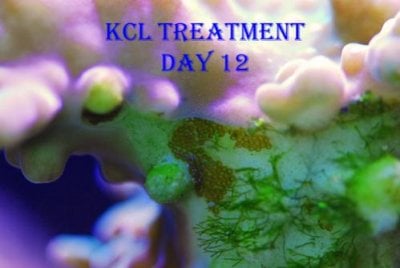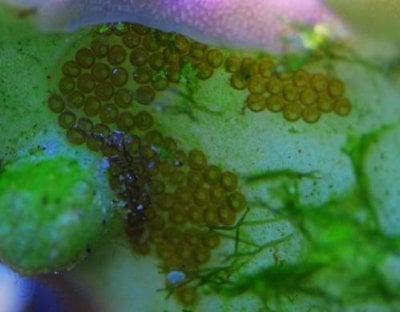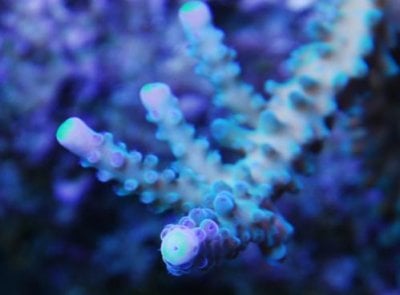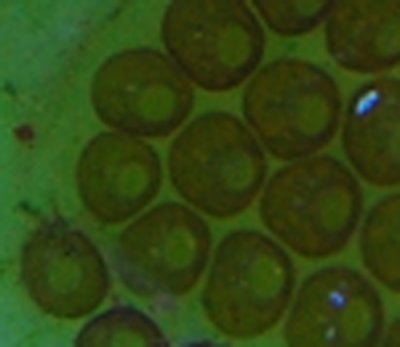good thread
Navigation
Install the app
How to install the app on iOS
Follow along with the video below to see how to install our site as a web app on your home screen.
Note: This feature may not be available in some browsers.
More options
You are using an out of date browser. It may not display this or other websites correctly.
You should upgrade or use an alternative browser.
You should upgrade or use an alternative browser.
An Almost Successful In Tank AEFW Treatment
- Thread starter Laser
- Start date
- Tagged users None
I want to treat just in case, but a 40lb bag? Sheesh, anyone wanna split a bag in SD?
Thanks for the thread!
*edit* Wait, 1 pound per gallon?
Thanks for the thread!
*edit* Wait, 1 pound per gallon?
Last edited:
I want to treat just in case, but a 40lb bag? Sheesh, anyone wanna split a bag in SD?
Thanks for the thread!
*edit* Wait, 1 pound per gallon?
1lb KCL for every 50 gallons tank volume
1lb KCL for every 50 gallons tank volume
Thank you for clarifying.
Sorry bout that now I see where the confusion set in....Thank you for clarifying.
Treatment for in tank:
llb KCL for every 50 gallons water volume of your system
Now for the mixing of the 1lb dry KCL. I found that for every 1lb KCL I could get it to totally mix by putting pump in 5 gallon bucket with 1 gallon of RO water... If I tried to mix with 1/2 gallon water took too long to saturate and not sure if it actually ever would...So for mix of KCL to use for treatment I used 1lb KCL for every 50 gallons. In this case his tank volume is 250gal so we used 5 lb total KCL. We then mixed the 5lb KCL with 5gal RO water and found we could totally saturate the solution for dumping into sump for 30 minute treatment.
Hope this clears it up..
Randy Holmes-Farley
Reef Chemist
View Badges
Staff member
Super Moderator
Excellence Award
Expert Contributor
Article Contributor
R2R Research
My Tank Thread
- Joined
- Sep 5, 2014
- Messages
- 67,438
- Reaction score
- 63,839
I recognize that AEFW can be a very serious issue for some folks, so what seems like a pretty extreme measure might be appropriate for some situations.
FWIW, this is a massive burst of potassium, and might be toxic to many creatures. It takes the normal 400 ppm to about 1660 ppm.
There are not many studies of potassium toxicity in marine creatures that I have seen because it would be a highly unusual event for it to become greatly elevated.
But assuming it kills both worms and fish, and causes corals to slime, I'd guess that it may kill a lot of creatures in the tank and folks might want to remove as many creatures as possible. Unfortunately, it may be the not easy to remove things (like other worms) that may be hit the hardest.
The subsequent water changes should be effective at bringing down the potassium as it won't appreciably bind to surfaces the way phosphate does. I think it might be an open question whether repeated treatments are better than one extended treatment time, but if it works, it seems a good way to go.
FWIW, this is a massive burst of potassium, and might be toxic to many creatures. It takes the normal 400 ppm to about 1660 ppm.
There are not many studies of potassium toxicity in marine creatures that I have seen because it would be a highly unusual event for it to become greatly elevated.
But assuming it kills both worms and fish, and causes corals to slime, I'd guess that it may kill a lot of creatures in the tank and folks might want to remove as many creatures as possible. Unfortunately, it may be the not easy to remove things (like other worms) that may be hit the hardest.
The subsequent water changes should be effective at bringing down the potassium as it won't appreciably bind to surfaces the way phosphate does. I think it might be an open question whether repeated treatments are better than one extended treatment time, but if it works, it seems a good way to go.
I read this treatment on a different forum over the weekend. Great thread, BTW.
I don't have any AEWF or red bugs but I wanted to test the spike and drop in K on a frag.
This past Sunday, I made a fresh cut of my red tabling milli. Here it is just after cutting:
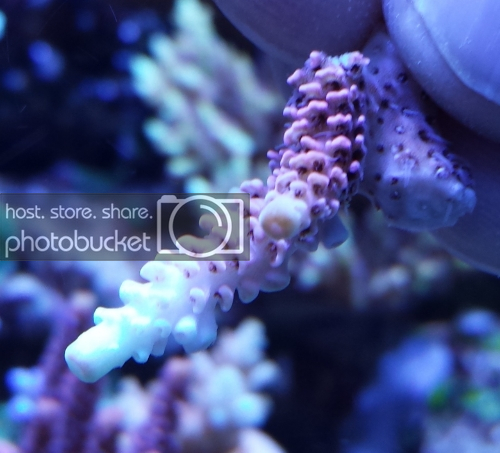
I then computed that I need one teaspoon of KCl per 1/2 gallon of tank water, that was already at 390 ppm, to get it to about 1600 ppm.
I mixed the water in a bucket with Brightwell's Potassion-P, placed some in a plastic bag and dropped the frag in it:
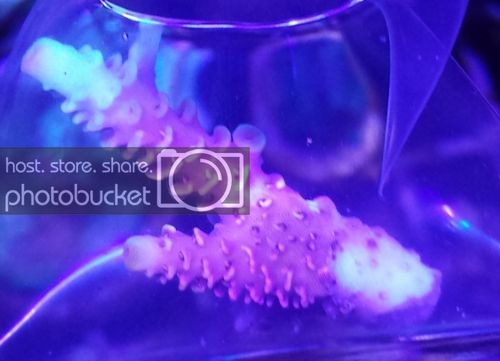
I floated this in the tank so that the change in water temperature wouldn't be an issue.
After the 30 minute dip, I put it on a plug and took this picture:
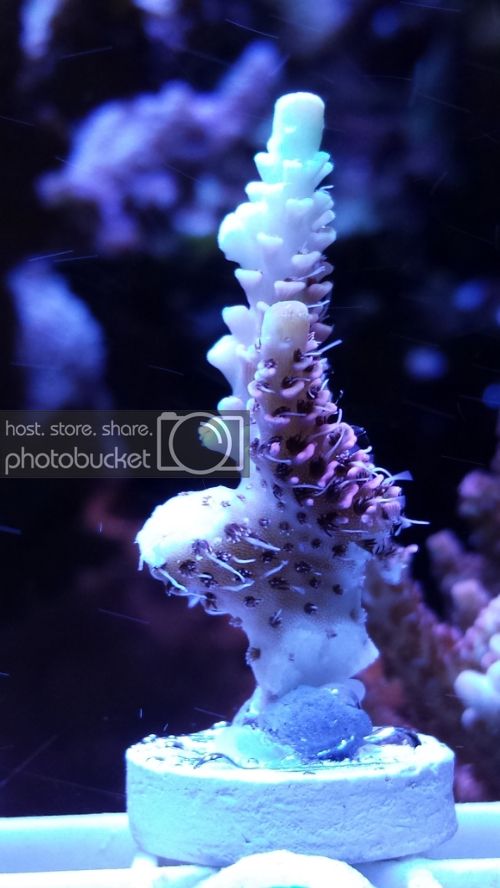
It looked like there were no issues. (Note that this acro's growth tips are white, that's not bleaching.)
Here's a picture of it yesterday, roughly 24 hours after the dip:
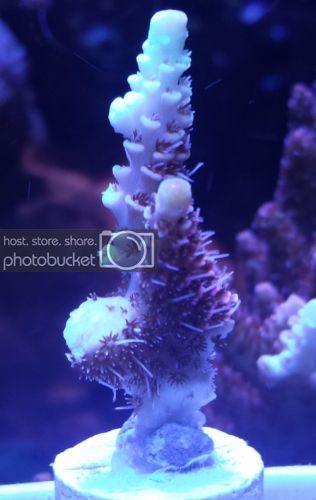
Still looking great!
I don't have any AEWF or red bugs but I wanted to test the spike and drop in K on a frag.
This past Sunday, I made a fresh cut of my red tabling milli. Here it is just after cutting:

I then computed that I need one teaspoon of KCl per 1/2 gallon of tank water, that was already at 390 ppm, to get it to about 1600 ppm.
I mixed the water in a bucket with Brightwell's Potassion-P, placed some in a plastic bag and dropped the frag in it:

I floated this in the tank so that the change in water temperature wouldn't be an issue.
After the 30 minute dip, I put it on a plug and took this picture:

It looked like there were no issues. (Note that this acro's growth tips are white, that's not bleaching.)
Here's a picture of it yesterday, roughly 24 hours after the dip:

Still looking great!
I recognize that AEFW can be a very serious issue for some folks, so what seems like a pretty extreme measure might be appropriate for some situations.
FWIW, this is a massive burst of potassium, and might be toxic to many creatures. It takes the normal 400 ppm to about 1660 ppm.
There are not many studies of potassium toxicity in marine creatures that I have seen because it would be a highly unusual event for it to become greatly elevated.
But assuming it kills both worms and fish, and causes corals to slime, I'd guess that it may kill a lot of creatures in the tank and folks might want to remove as many creatures as possible. Unfortunately, it may be the not easy to remove things (like other worms) that may be hit the hardest.
The subsequent water changes should be effective at bringing down the potassium as it won't appreciably bind to surfaces the way phosphate does. I think it might be an open question whether repeated treatments are better than one extended treatment time, but if it works, it seems a good way to go.
Completely agree that is is a desperation move and as you mentioned there will be a ton of death in the tank associated with the event. I knew this would be the case and as I implied to all it is necessary to remove as many fish, shrimp, cleanup crew etc that you can get. I am still amazed at the fact that many of the snails have now returned to working on the new algae outbreak due to the change from low nutrient to high nutrient overnight.
I guess the question going forward is will the initial treatment kill the eggs and not allow them to hatch. I have been observing a coral with eggs that were treated and still have not hatched at day 12. I should say to my limited knowledge of viewing AEFW eggs they dont appear to be hatched. We are still actively trying to reach Kate Rowlison to discuss our findings and what we may look for with the egg clusters.
I read this treatment on a different forum over the weekend. Great thread, BTW.
I don't have any AEWF or red bugs but I wanted to test the spike and drop in K on a frag.
This past Sunday, I made a fresh cut of my red tabling milli. Here it is just after cutting:

I then computed that I need one teaspoon of KCl per 1/2 gallon of tank water, that was already at 390 ppm, to get it to about 1600 ppm.
I mixed the water in a bucket with Brightwell's Potassion-P, placed some in a plastic bag and dropped the frag in it:

I floated this in the tank so that the change in water temperature wouldn't be an issue.
After the 30 minute dip, I put it on a plug and took this picture:

It looked like there were no issues. (Note that this acro's growth tips are white, that's not bleaching.)
Here's a picture of it yesterday, roughly 24 hours after the dip:

Still looking great!
I understand that it is a half pound KCl per gallon, not half teaspoon. On another forum discussing this subject:
DFW wrote: "Are you saying that you would add 100 pounds of KCl to a tank that has 100 gallons of water? And then drain all of the water and replace with fresh salt water?"
Laser wrote: "works out to 1lb of KCL for every 50 gallons tank volume, let sit in tank 30 minutes, then commence with the water changes."
shots from day 12 observation with zoom look. The eggs appear to have white specs in them and I have not been able to observe any movement through the camera zooom. Also included a pic of the same coral that was almost a goner before treatment, had totally lost color, no PE, and the base --well you can see that pretty good. Colors have already come back, PE somewhat back and recovering nicely.
Attachments
Ok all you experts on AEFW what is the opinion of the eggs? It certainly appears to be some embryos in there. Do they typically look white while in the egg? I cannot see any movement..
We will be conducting the second treatment Thursday at 10 central.
We will be conducting the second treatment Thursday at 10 central.
I understand that it is a half pound KCl per gallon, not half teaspoon. On another forum discussing this subject:DFW wrote: "Are you saying that you would add 100 pounds of KCl to a tank that has 100 gallons of water? And then drain all of the water and replace with fresh salt water?"
Laser wrote: "works out to 1lb of KCL for every 50 gallons tank volume, let sit in tank 30 minutes, then commence with the water changes."
If it's 1 pound for 50 gallons, it's 1/50 of a pound per gallon or 1/100 of a pound per 1/2 gallon. .01 pounds is equivalent to 4.5 grams and using the following reference, 4.5 grams of KCl equals 1 teaspoon.
Mass-Volume Equivalents of Common Chemical Solids
How long does it normally takes for them to hatch? Die you cursed pest eggs!
From everything that I have ready the common belief currently is 14 days. Kate Rowlison is doing extensive research on exactly that question so I have been actively trying to get in touch with her. If anyone knows how to reach her please have her contact me to discuss.
That being said I becoming a bit concerned with the eggs---I.E. the bottom left one in the zoom-- as you can see what may be tentacles sticking out? Maybe I am getting a bit paranoid watching these booogers too long....
From everything that I have ready the common belief currently is 14 days. Kate Rowlison is doing extensive research on exactly that question so I have been actively trying to get in touch with her. If anyone knows how to reach her please have her contact me to discuss.
That being said I becoming a bit concerned with the eggs---I.E. the bottom left one in the zoom-- as you can see what may be tentacles sticking out? Maybe I am getting a bit paranoid watching these booogers too long....
Mr. Saltwater Tank, a.k.a. Mark Callahan, interviewed her. Maybe it's easier to get in touch with him to get in touch with her.
Mr. Saltwater Tank, a.k.a. Mark Callahan, interviewed her. Maybe it's easier to get in touch with him to get in touch with her.
Im on it! Great idea...
Just sent Mr. Saltwater an email hopefully he will get back with me..
Last edited:
I read an a research article somewhere it said AEFW eggs take up to 30 days to hatch and each egg contains between 4-6 embyos! If the eggs are getting large that means they are not dead or I guess you will have to wait past 30 days to find out
If it's 1 pound for 50 gallons, it's 1/50 of a pound per gallon or 1/100 of a pound per 1/2 gallon. .01 pounds is equivalent to 4.5 grams and using the following reference, 4.5 grams of KCl equals 1 teaspoon.
Mass-Volume Equivalents of Common Chemical Solids
Praise God! I was dumping a whole bag in your tank! Oh no! Thank you for your correction!!!!! I had got it in my head that he was using a half pound in every gallon.
Similar threads
- Replies
- 2
- Views
- 119






